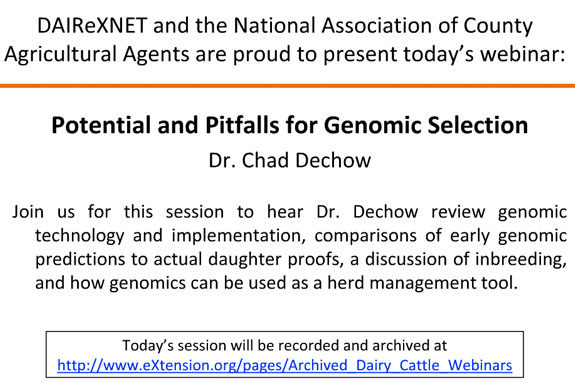Have you considered the potential impact genomics could have on your herd? This is a topic that has probably crossed most dairy producers’ minds. On January 14, 2013, Dr. Chad Dechow, associate professor of dairy cattle genetics at Penn State University, led a webinar focusing on the “potentials” and “pitfalls” of genomic selection. Dechow began by pointing out that everyone has a different perspective on genomics as well as the right and wrong areas in which to use genomics.
During the hour-long presentation, Dechow reviewed the following areas relating to genomics: reviewing genomic technology and implementation, comparing early genomic predictions to actual daughter proofs, genomics as a herd management tool, inbreeding and going beyond single nucleotide polymorphisms (SNPs).
Dechow started the presentation with a discussion on the progress that has been made in genomic information, starting with the investigation of single genes.
When the gene diacylglycerol acyltransferase 1 was removed in mice through genetic engineering, there was a complete absence of milk production. The gene was then flagged as an area that impacted milk production traits.
He pointed out that a small mutation in this gene can change a lysine amino acid to an alanine amino acid, which causes an increase in milk production and protein production.
At the same time though, fat production decreased. The transition also caused less saturated fat and more non-saturated fat.
Dechow explained that while this was terrific, more information would be necessary, which led to looking at genomics through a whole-genome approach rather that focusing on one specific gene. In following this approach, SNPs are reviewed.
He explained tests are currently available that can determine SNPs, including the Bovine SNP 50, which forms most of the basis of current genomic predictions.
While whole-genome sequencing is also an option, Dechow pointed out that this alternative generates such a large amount of data that it cannot be analyzed efficiently at this point.

He then continued to review a formula that is used to determine the amount of genetic progress that can be achieved in one year.
“This formula tells you why geneticists get excited about genomics,” he says.
The formula consists of four functions, such as the accuracy of predicted transmitting ability (PTA). Dechow explained that reliability is used to measure PTA in the U.S. dairy industry.
Selection intensity is the second function, which as Dechow explained, depends on how picky a producer is in selecting bulls.
The next function is the amount of genetic variation within a population, and the last component is the generation interval, which is how old parents are when their offspring are born.
Dechow explained that genomics are currently helping the industry in three different ways: by lowering generation interval, improving accuracy for females and the ability to make some progress on selection intensity.
“Now we don’t have to go to through the expense of progeny testing a bull; we can just do a genomics test and test more bulls indirectly that way,” he said. “The challenge that we’ve always had in order to find out who the very good bulls are was we had to wait until the bull was about 6 years old before the bull had daughters that were giving milk, which increased the generation interval.”
Dechow explained how genomic proofs were implemented for the first time in January of 2009 – and have been quickly adopted since then. He compared the genomic predictions of bulls from January of 2009 to see where these bulls stood today.
“There are a lot of success stories, and then a few cases where things haven’t gone quite as accurately as we’d hoped,” Dechow said.
The following section of the presentation focused on how to use genomics as a herd management tool. Dechow explained genomics can offer a replacement for visual-appraisal mating programs.
Another way, he explained, would be to look at a cow’s transmitting ability on a chromosome-by-chromosome basis, and mate to improve certain chromosomes.
“Genomics can play a role for commercial milk producers and particularly those with heifers to sell,” Dechow said.
He explained that because of sexed semen, heifer replacement numbers have increased. One of the strategies to address this issue involves increasing culling rates on the farm, which could lead to fewer problems with older cows and milking fewer mature cows.
However, Dechow pointed out that the producers still have to raise and feed the heifers, which doesn’t help lower feed costs. This is the point where selling the heifers becomes an option for producers.
“The question becomes: Which heifers do I want to sell? That’s where genomics can help us out,” Dechow said.
Dechow discussed possible scenarios where the value of genomic testing of calves in order to find out which calves to sell was evaluated.
Inbreeding and genomics was the next area that Dechow reviewed. He stated that the rate of inbreeding is going to accelerate with genomics because there is now a shorter generation interval and because the technology uses pattern recognition, which recognizes a pattern of SNPs.
“What we are doing with genomics is picking those that have the most recognizable patterns or those most related to the breed,” he said. “That is going to accelerate inbreeding in populations.”
On the other hand, Dechow explained that genomics provides the opportunity to develop inbred lines more quickly. These inbred lines can then be crossed in the commercial cow population to avoid inbreeding in the commercial cow population.
“There is some potential for genomics to help us on the inbreeding front if line development works,” he said. “If it doesn’t work, it could pin us to an inbreeding corner.”
Dechow concluded his presentation by discussing why genomics tests aren’t 100 percent accurate. He explains that there is still a ways to go before genomics tests are 100 percent accurate. However, he also commented that there are still many possibilities in using genomics. PD
Click here to view the entire webinar or to view other archived DAIReXNET webinars. Click here to see a list of upcoming webinars.

Dario Martinez
Editor
Progressive Dairyman magazine







